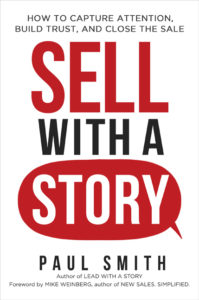Podcast: Play in new window | Download | Embed
Subscribe: RSS
Podcast (sell-with-a-story-series1): Play in new window | Download | Embed
Subscribe: RSS
 Imagine it’s 9 o’clock on Monday morning, three days before a big sales call with a new prospect. The entire team is sitting in a conference room ready to start planning the sales pitch. At 9:02, the sales VP walks in the room and calls the meeting to order with a clap of her hands. She puts her hands down on the conference table, leans out over the surface, and says, “Okay, people, what’s our story?”
Imagine it’s 9 o’clock on Monday morning, three days before a big sales call with a new prospect. The entire team is sitting in a conference room ready to start planning the sales pitch. At 9:02, the sales VP walks in the room and calls the meeting to order with a clap of her hands. She puts her hands down on the conference table, leans out over the surface, and says, “Okay, people, what’s our story?”
Now, do you think for a single minute that she’s asking for an actual story in the traditional sense? Almost certainly not. She’s probably asking for the logical series of facts and arguments and data the team should lay out for the prospect, probably in a PowerPoint presentation, that will have the greatest odds of leading to a sale. That would certainly be a reasonable request. But it’s not something anyone would have called a story 10 years ago. It would have been called a message track, or talking points, or presentation slides, or simply a sales pitch.
In the last few years, it’s become popular to call just about any meaningful series of words a story. Our strategy document is a story . . . the mission statement is a story . . . our co-marketing programs are stories . . . our brand logo is a story . . .
If using the word story for all those purposes helps people find or create more meaning in their work, then that’s obviously a good thing.
But for my purposes here, those are not stories. Not every set of words that has meaning is a story, just like not all collections of words constitute poetry. A story is something special.
So, how can you distinguish a story from other narratives that are not stories? We need some practical tips to recognize a story.
The most sensible attempt I’ve seen to do this is by business storytelling consultant Shawn Callahan. He even created a 10-story quiz at www.thestorytest.com to help people practice identifying general business stories from nonstories. I encourage you to try the quiz yourself.
Six Attributes of a Story
Inspired by Callahan’s work, here are my top attributes that distinguish a story from all other forms of narrative. Real stories have the following six identifiable features:
- a time
- a place
- a main character
- a goal
- an obstacle, and
- events
That last one is especially important because for a narrative to be a story, something has to happen. Statements about your product’s amazing capabilities or your service commitment, or testimonials about how awesome your company is, generally aren’t stories because they don’t relay events. Nothing happens in them. They’re just someone’s opinion about something. If nothing happens, it’s not a story.
When you find these six features in a narrative, it’s a good indication that what you’re experiencing is a story.
Sales Story Test
Let’s give these criteria a test drive and see how they work. Similar to Shawn Callahan’s story test, below are three narratives that may or may not be rightly called a story, but specifically in a sales context. Your job is to decide which are and which are not stories, and why. We’ll score your answers after the narratives.
Narrative #1: Are your teeth stained or yellow? Are you embarrassed to smile at parties or in pictures or videos, especially next to your friends with movie-star smiles? Have you tried teeth whitening systems but given up after a few days because they made your teeth too sensitive? If so, Ultra-White is right for you. It’s the revolutionary new teeth whitening system designed by Hollywood dentists to give you star-quality whiteness without all the pain and discomfort. Ultra-White involves a two-step process that alternates applications between a high-impact whitening paste and a desensitization gel. The result is sparkling white teeth without any discomfort that would keep you from showing off your new Hollywood smile.
Narrative #2: A couple of years ago, Dave Neild, the network service leader at the University of Leeds in the UK, realized he had a problem. He was getting cease and desist orders and copyright violation notices from all over the world as a result of students using file-sharing services like BitTorrent. In addition, many of the students were showing up in his office with computers infected by viruses. It took his staff up to an hour to clean up each one. Dave agreed to do a test with Hewlett-Packard’s TippingPoint network security device to see if that could help. When the test was over, he told us, “As soon as we installed TippingPoint, we instantly stopped receiving copyright notices. That protected our students from getting threatened by lawyers, and it protected the reputation of the university.” The university also got about 30 percent of its lost bandwidth back from the reduction in file sharing.
Narrative #3: You should be using your shoppers’ planned purchases of toothpaste to sell more toothbrushes. Currently, shoppers buy toothbrushes only about every six months, despite the fact that dentists suggest replacing a toothbrush every three months. But your shoppers are already in your Oral Care aisle every two months to buy toothpaste. If you co-merchandised toothbrushes with toothpastes, you could close more of your shoppers with toothbrushes. And toothbrushes help sweeten the profits for you as a retailer. The average toothpaste category profit margin is only X percent, but the profit margin on toothbrushes is usually double that. And your own sales data show a dramatic increase in toothbrush sales when merchandised with toothpaste. Our February co-merchandising event delivered a 22 percent sales increase on toothbrushes over three weeks. That was $YY million in incremental sales. This was by far the best toothbrush sales month of the year. Even bigger than Christmas!
Okay, let’s see how you did.
First off, admittedly none of these are earth-shatteringly great stories. But some of them are stories, and some of them are not.
Narrative #1 (Ultra-White): Not a story—Let’s walk through all six criteria. There is no time and no place mentioned. There’s also not a clear main character, although “you” is mentioned several times. There does appear to be a main obstacle (yellow teeth and the discomfort of most teeth whitening systems). And there is clearly a goal (whiter teeth). Finally, and most tellingly, there aren’t any events that occur in the narrative. Nothing happens. Net, this narrative contains only two or three of the six criteria. It might make for a good advertisement. But it’s not a story.
Narrative #2 (TippingPoint): Story—There is a time (two years ago), a place (University of Leeds), a main character (Dave Neild), an obstacle (cease and desist orders), a goal (stopping the orders), and events (students sharing files and the university running the TippingPoint test). This has all the indicators of a story.
Narrative #3 (Oral Care): Not a story—This one is tricky. It’s exactly the kind of narrative professional salespeople use all the time, and they might easily refer to it as a story. But let’s look at the criteria. There are time references to February and Christmas, but most of the text doesn’t involve those times. There is no place mentioned. It’s confusing who the main character is. Sometimes it appears to be “you” (the retailer) and sometimes it appears to be the shopper. It goes back and forth. The obstacle appears to be the current merchandising practices, and the goal is clearly to sell more toothbrushes. But the events are a hodgepodge of things the shopper does, things the buyer did, and things the buyer and seller did together. This one meets two of the six criteria well, and it’s muddled at best on the other four. This narrative is best described as a persuasive sales pitch, and it’s a pretty good one at that. But it’s really not a story.
So, now we know what a story is and how to recognize it. That was the hard part. Now for the easy part. What’s a sales story?
A sales story is any story that’s used in the process of earning a sale and maintaining a customer. That’s it. As you’ll see in later episodes, stories can be used in any phase of the sales process, from stories you tell yourself prior to the sales call, to building rapport with the buyer, to the sales pitch itself, to negotiating price, to closing the sale, and even after the sale to manage the customer relationship. For our purposes in this podcast, all of these are sales stories. And I’ll share a number of examples in future episodes.
Special Offer: As a thank you and reward for listening to or reading this new podcast series, I’m giving away three free copies of the Audible edition of the book it’s based on, Sell with a Story: How to Capture Attention, Build Trust, and Close the Sale. That’s the downloadable audio version that you would listen to on your phone or in the car. If you’d like to win one of those, click this link and play this podcast directly from iTunes. You can skip to the last 60 seconds of the podcast where you’ll find instructions for how to win one of the free Audible books. I’ll leave the contest open for 2 weeks after this podcast first posts. Good luck!
[You can find this and dozens of other examples and lessons on storytelling in sales in my book, Sell with a Story.]
—
 Paul Smith is one of the world’s leading experts on business storytelling. He’s a keynote speaker, storytelling coach, and bestselling author of the books Lead with a Story, Parenting with a Story, and Sell with a Story.
Paul Smith is one of the world’s leading experts on business storytelling. He’s a keynote speaker, storytelling coach, and bestselling author of the books Lead with a Story, Parenting with a Story, and Sell with a Story.


 Connect with him via email here.
Connect with him via email here.
Follow him on Facebook, LinkedIn, Twitter, and Instagram.
Sign up for his newsletter here to get one new story a week delivered to your inbox.


[…] 4. Podcast: Six Differences Between a Sales Story and a Sales Pitch […]
Thank you, for this information on a story. It really is surprising that we do not know about stories. You put it very concisely.